This $5 Million Roger Smith Pocket Watch Just Became the Most Expensive British Timepiece Ever Sold
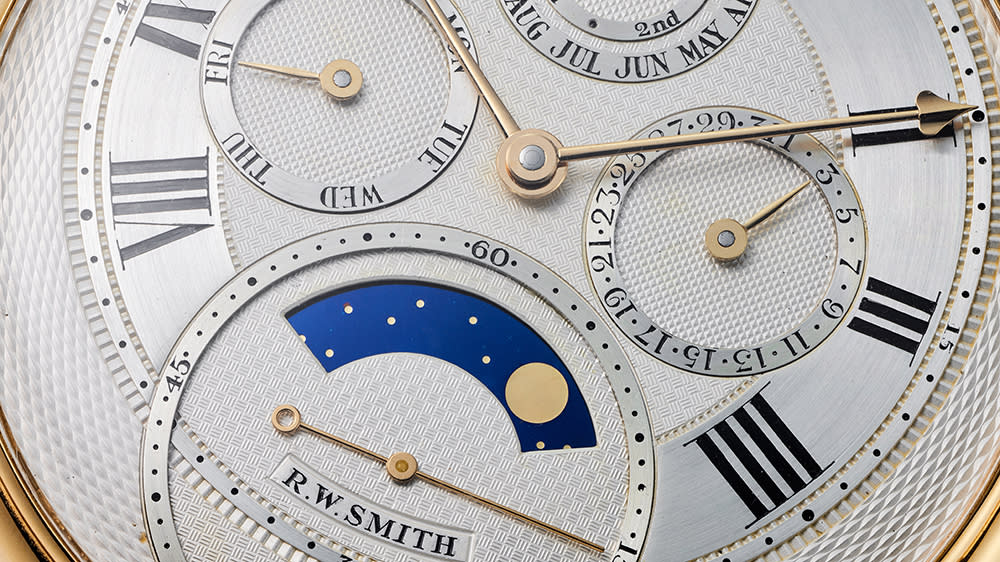
Suffice it to say that it was quite a week in the auction world.
The long processional of wildly valued stainless steel sports watches momentarily subsided in lieu of a timepiece that, well, actually seems to deserve its valuation: On June 11, British watchmaker Roger Smith’s completely handmade Pocket Watch Number Two hammered for $4.9 million—the most ever realized by a British timepiece, at Phillips The New York Watch Auction: Eight. More on that in a moment.
More from Robb Report
Gustav Klimt's Last Portrait Is Expected to Fetch a Record $80 Million at Auction
MB&F's New HM8 Watch Gets Its Sleek Body Design From the Porsche 918 Spyder
Tom Brady Wore a Rare Platinum Rolex With an Eastern Arabic Dial to the French Open
Additionally, a new world record was realized for what could more accurately be described as a piece of modern art, rather than a wristwatch: A Patek Philippe Ref. 2481 with a stunning cloisonné enamel dial from 1952 sold for $1,117,600 to someone who, presumably, A) really likes depictions of forests; B) really likes gold; C) really likes Patek or; D) really likes the intersection of all three of these things at one time. (Or, someone who is Patek Philippe—though the brand already owns two of these in its museum.)
In other news: people are still willing to pay lots of money for stainless steel sports watches. To wit: a Heuer Seafarer Ref. 2447 retailed by Abercrombie and Fitch in New York City in 1968 hammered for an eye-watering $40,320 at Christie’s on June 6. (And I thought it was bonkers when these early Seafarers were trading in the mid-20s a few years back. Le sigh.) And of course, a notable Rolex—and an interesting one, at that: A complicated Ref. 6236 “Jean-Claude Killy” realized $264,600. (A bargain, considering Paul Altieri once purchased one for $350,000 from a man who found it on a golf course when caddying as a young man. Sheesh.)
But the truly big news out of Christie’s was an über-complicated Ref. 5074J-001 “Cathedral” from Patek Philippe. “Exceptionally rare and impressive”—not uncommon adjectives to find in a watch auction catalog—this 18K yellow gold perpetual calendar minute repeater hammered for a cool $403,200. According to Christie’s, it’s one of just 12 examples to have ever been publicly offered for auction. (Also, it features “extra long gongs.” Do what you will with that information.)
Over at Sotheby’s, two Rolex Daytonas owned by Paul Newman himself were on offer, attracting a bidding frenzy that saw each watch hammer for over $1M. The house also had a very special “pink-on-pink” ref. 1518 perpetual calendar chronograph from Patek Philippe for interested parties to war over, which ended up selling for ~$4M. In short: it was quite a week for the auction house, which realized $16.4M in its Important Watches sale.
Phillips: Roger Smith Pocket Watch Number Two
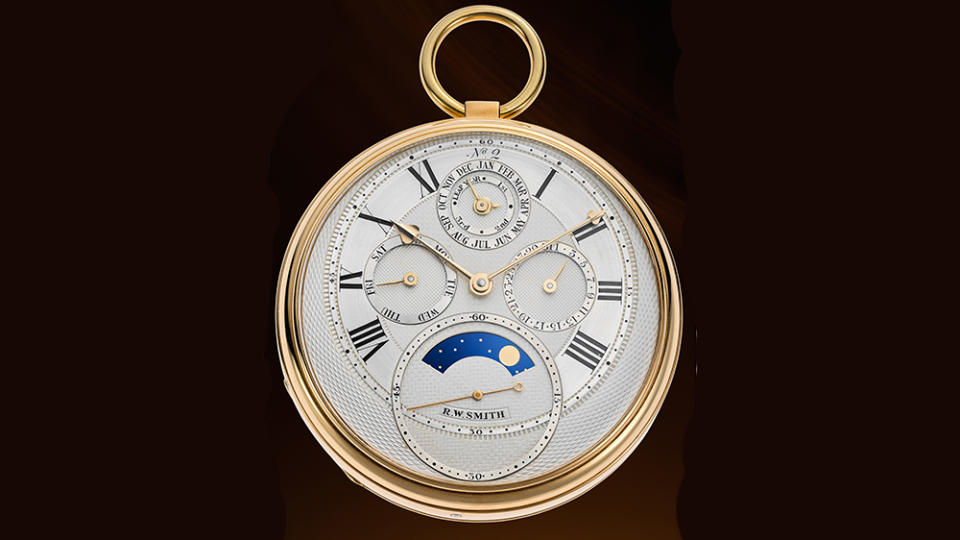
In case you’re unfamiliar: Roger Smith is possibly the most important watchmaker on Earth at the moment. In a story that sounds distinctly like something out of a Tolkien novel, Smith labored (or, in British English, laboured) for more than 18 months to create a pocket watch, by hand, that would live up to the standards of George Daniels, with whom he sought to secure an apprenticeship. (Daniels, inventor of the co-axial escapement, was indisputably the most significant watchmaker of the 20th century.) Daniels rejected his first attempt, but Smith was no quitter: He returned to his parents’ garage (seriously), and after more than five years, presented Pocket Watch Number Two to Daniels, who either proclaimed (or reluctantly muttered): “You are now a watchmaker,” and accepted Smith into his workshop on the Isle of Man.
This truly exceptional work of horological art is housed in a 66.5mm yellow gold case and features a perpetual calendar, a tourbillon, and a hand-wound movement with a spring detent escapement. Dating to 1998, every component was hand-made by Smith, resulting in what is surely one of the most beautiful modern timepieces ever built, and what its maker has deemed “…the most important watch I’ve ever made, without a doubt.” Given an estimate in excess of $1 million, the watch hammered for $4.9M million, making it a world record for any auctioned timepiece by Roger Smith—and for any auctioned British timepiece, full stop.
Phillips: Patek Philippe Ref. 2481 “Pristine Forest”
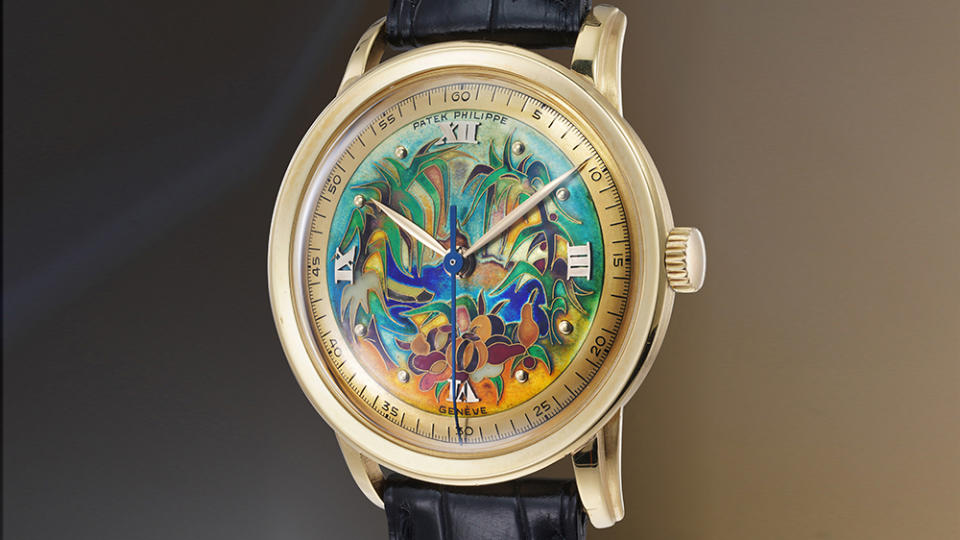
Another world record was reserved for a reference from Patek Philippe that, while it may not be as well known to collectors as its more complicated brethren, certainly deserves their attention: A large (for the time) 36.5mm yellow gold, time-only Calatrava-style watch, this particular Ref. 2481 features a stunning, cloisonné dial depicting a tropical forest. Produced in 1952 and sold in 1954, it has remained in the same family for nearly seven decades.
One of the largest wristwatches produced by Patek upon its introduction, it features a notable case design with a concave bezel and claw lugs, giving it shape and body that wasn’t present on other time-only references from the same time period. While you’ve no doubt seen this watch before with a more common silvered dial, it’s the cloisnné enamel versions that truly stop watch collectors in their tracks. This technique involves placing thin gold wire on a metal base, within which powdered enamel in different colors is filled and fired, solidifying it. Difficult to produce and extremely expensive, watches with cloisonné enamel dials were made in small numbers by only the most skilled artisans.
Featuring applied gold Roman and dot indices, a gold feuille handset with a blued steel seconds hand, and an outer 1/5th-seconds track, this ref. 2481 is believed by Phillips to be one of just 10 produced with this “pristine forest” dial type, with two similar examples owned by Patek itself and housed in the brand’s museum. Offered in pristine condition with its presentation box and previously unknown to the market, it’s little wonder that such a timepiece achieved a world record.
Sotheby’s: Two Rolex Daytonas Owned by Paul Newman
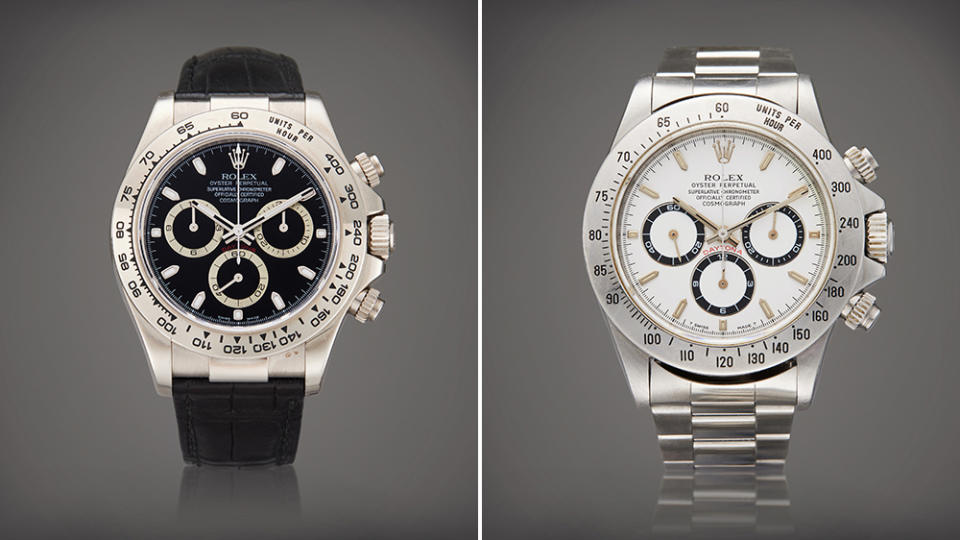
For the uninitiated, a “Paul Newman” Daytona describes a particular subset of the famous Rolex chronograph in which the dials—made by the Singer company—feature special, Art Deco-style typography, box-shaped indices within the sub-registers; a contrasting minute/seconds scale; and, often, the “Daytona” text in red. Sometimes, however, a Rolex Daytona actually belonged to famed actor and philanthropist Paul Newman, putting it in a class completely its own!
Last week, two such watches came under the hammer at Sotheby’s as part of the house’s The World of Joanne Woodward and Paul Newman auction: The first, a 5-digit Ref. 16520 “Zenith” Daytona with a white dial, hammered for $1.1M following a bidding war between three interested parties. Newman, a lifelong lover of auto racing and a dedicated and winning driver himself, was awarded the watch following his team’s victory in the GTS-1 class at the 1995 24 Hours of Daytona. (Newman, then 70, became the oldest driver to ever win the race, snagging a Guiness World Record.) The watch is inscribed “Rolex at Daytona 24 Paul Newman Rolex Motorsports Man of the Year 1995” on the caseback, and is powered by the famous Zenith El Primero movement, which Rolex featured in its Daytona models between 1988 and 2000.
The second watch, if not imbued with racing provenance, is also highly significant: The last of three Rolex Daytonas gifted by Joanne Woodward to Paul Newman during their marriage, it’s a 6-digit Ref. 116519 with a black dial. An automatic, white gold Daytona with an in-house Rolex movement stemming from circa 2006, it was the only precious-metal Daytona owned by the actor, and features a variant of his wife’s now-famous (and highly charming) wish/admonition on the caseback: “DRIVE VERY SLOWLY JOANNE.” Newman wore the watch on August 13, 2008 during laps at Lime Rock Park prior to his passing in September of that year. Bidded up by four interested parties, it similarly hammered for $1.1 million.
Sotheby’s: Patek Philippe “Pink-on-Pink” Ref. 1518
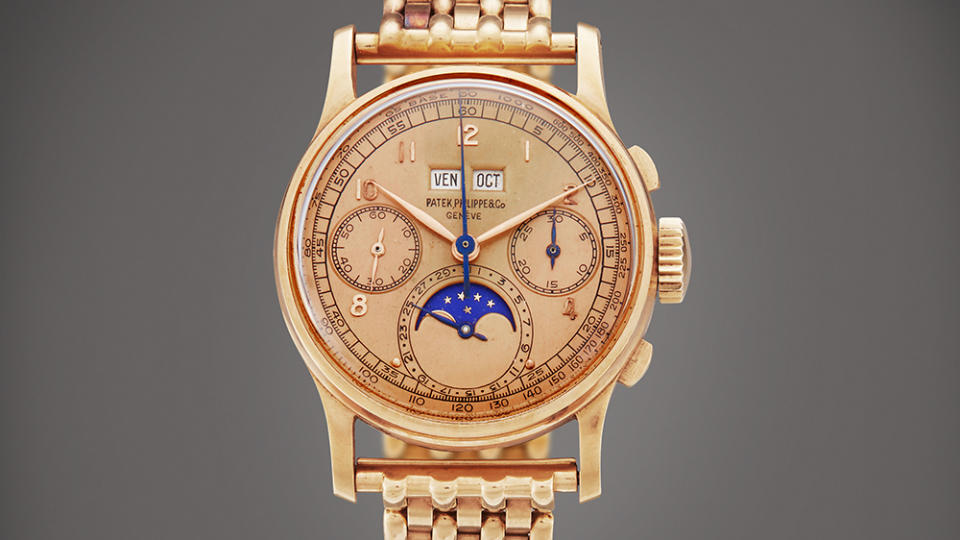
Known for its complicated watchmaking, Patek Philippe was the first watchmaker to serially produce a perpetual calendar chronograph way back in the early 1940s, while everyone else was busy warring with one another. The Ref. 1518 is thus not only a highly significant watch, horologically, but has since become a darling of the auction world, with examples in precious metals hammering for millions given their rarity. (Only 281 total examples across all metals were ever created.)
Two bidders duked it out for five minutes over a special “pink-on-pink” version of the reference came to the fore, fresh to the market and previously unknown. Having evidently remained in the possession of the original owner since its purchase in 1947, it’s only the 15th known example of a pink gold version of the watch with a salmon gold dial, out of 58 examples total cased in pink gold. (Only 10 are ever known to have come up for sale.) In the end, it hammered for $3.9 million, proving that complicated Patek still occupies a significant amount of collectors’ mindshare.
Christie’s: Patek Philippe Ref. 5074J-001 “Cathedral”
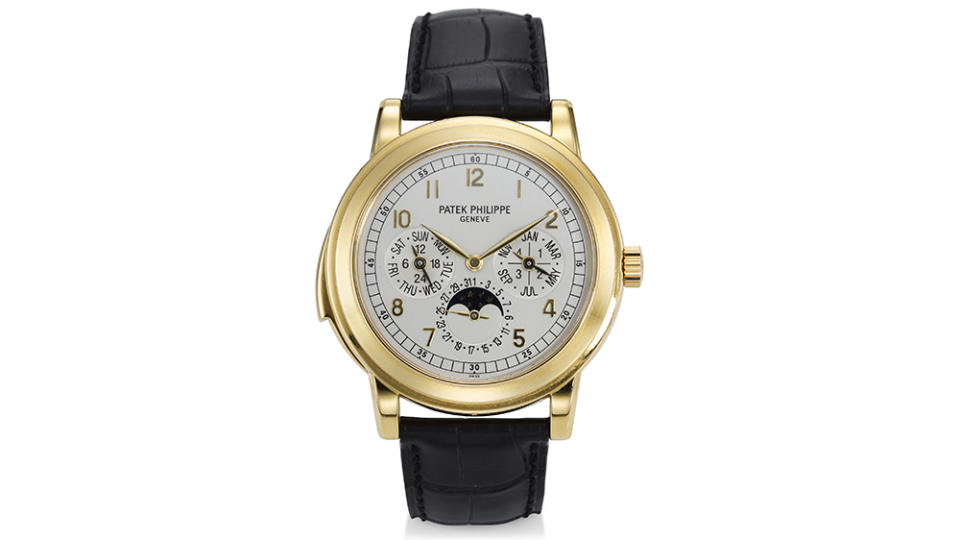
One of just 12 examples of this reference to have been offered publicly at auction, the 5074J-001 is yet further proof of Patek’s dominance of complicated, serially produced watchmaking. Dating to 2002, this piece is large and in charge: Measuring 42mm wide and housed in an 18K yellow gold case, it clearly takes inspiration from the long lineage of Patek Phillipe QPs that have come before it, including the Ref. 1518 from the 1940s and the coveted 2499. The “Cathedral,” however, includes a minute repeater function, as indicated by the slider protruding subtly from the left case flank. It’s also notably an automatic watch—its in-house Caliber R 27 Q features a micro-rotor with grain d-orge finishing, plus Côtes de Genève and anglage finishing throughout. It’s visible through a sapphire caseback.
Very few wristwatches manage to marry complicated functionality to a highly legible and cleanly organized dial. Patek, of course, is a master of this art, with many decades of experience in crafting such timepieces. As the market for stainless steel softens somewhat from its mid-pandemic highs, it’s notable to see top lots from the major houses include complicated and precious metal watches, both of the vintage and contemporary persuasion. While there’s no doubt that serious collectors will continue to pay big money for super “hyped” timepieces like “Paul Newman” Daytonas and various “luxury sports watches,” the rarity and craftsmanship inherent in pieces like the Ref. 5074J-001 seems to better warrant these sky-high valuations.
Best of Robb Report
Sign up for Robb Report's Newsletter. For the latest news, follow us on Facebook, Twitter, and Instagram.

